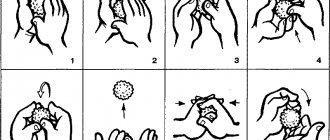In this article I will write about two possible options for teaching a child to swim: “express” (literally in 1-2 lessons) and “academic” (longer and higher-quality training).
Attention! This article is dedicated to teaching children aged 6-9 years and older. If you are interested in teaching for a younger age, I have a separate article devoted to this issue.
Features of school age
Unlike younger children, starting from 6-7 years old, the child is already ready for the learning process - ready to consciously perform exercises and tasks. It is from this age that people are accepted to study at a sports school.
In this regard, there is no longer a need to teach through games (as with little ones), and at the same time it is possible and necessary to instill in the child the correct swimming style.
However, in relation to schoolchildren, the parent’s task is to ensure that the child has a desire to take up swimming, that is, to interest him, and not to force him .
I would also like to note that under no circumstances should you scold a child if he has taken too much water - you need to treat it calmly (for more details, see here). The goal is for positive results to come from classes. Praise your child often.
General Tips
To ensure that children enjoy swimming lessons and bring results, we offer the following general tips:
- Classes should take place in the form of a game, especially for children under 7 years old and at first.
- Classes should be relaxed. You can't put pressure on children. If your child doesn’t want to study, then figure out how to interest him. If he persistently refuses, don't force him. Reschedule the lesson for next time.
- Praise the child. Praise is always needed, even if there is no success yet.
- Stay close to the water. At the same time as your child, do all the exercises, play, and get involved in the competition. Children will better understand the exercise if it is shown clearly.
- Don't scare your child in the water.
- Do not be afraid yourself, because children perfectly sense the state of their parents.
- Don't expect quick results. All children are individual. Some will swim earlier, others will take longer.
Do not give your child gifts for an activity. He should feel the joy of swimming, and not of being rewarded for his “torment.” Figure out how to make your baby's stay in the water enjoyable.
It is better to teach a child to swim in a pool. In the sea, waves interfere with the learning process. The water in the river is not so clear that it interferes with the first lessons. The water in the pool is clear and at a comfortable temperature. In addition, the baby has the opportunity to push off from the walls and bottom of the pool.
Basics of proper swimming
I write about this in many articles on this site and, just in case, I will repeat it here again (if you have already read or understand the issue, feel free to move on to the next section of the article).
Correct swimming is swimming with your head in the water . Inhalation, of course, is done as a result of lifting (in breaststroke) or turning (in crawl) the head, exhaling into the water with your nose or mouth. This is the kind of swimming that needs to be taught.
Any person, and especially a child, instinctively strives to lift his head up - this is at least necessary for comfortable breathing. On the contrary, putting your face in the water and swimming in this position is not a very natural action for a person.
However, it is correct to swim with your face in the water:
- Firstly, a raised head upsets the balance of the body, and the legs and pelvis begin to sink .
- Secondly, it prevents the body from stretching and disrupts buoyancy.
- Thirdly, if we talk about long-term exercise, then pinched cervical vertebrae and compressed blood vessels are, at the very least, not good for health.
Correct head position in freestyle swimming
In addition, since we are talking about training, it is also much easier to learn swimming from scratch with your head down rather than with your head up. By lowering his face into the water and drawing air into his chest, even the most beginner will be able to float on the water like an asterisk (and this is half the way!), while with his head raised it will be extremely difficult for a beginner to stay on the water.
Your task is to teach your child to swim with his head in the water. This does not mean that he will swim like this all the time in the future. On the contrary, children who have learned then often bathe, swimming crawl with their heads raised. But they already know how to swim, that is, the task of teaching has been achieved.
Optimal age of the child
A lot has been said about the benefits of swimming; it is unlikely that anyone today will refute the obvious. If we talk specifically about the advantages of this sport for children, we will highlight the following points:
- Swimming develops a child physically. Trains muscles, posture, strengthens the musculoskeletal system, improves coordination;
- Children who regularly go swimming in the pool get sick less. Training helps to harden and strengthen the immune system;
- Competitive swimming improves endurance and strength, and also increases self-esteem;
- It also gives positive emotions, helps you relax, and calms the nervous system.
At the same time, you don’t have to force your child to pass the standards for a category or title. It is quite enough to simply teach your child to swim in the pool and turn these activities into a useful and regular habit.
The best age to teach a child to swim is between 3 and 4 years old.
Children under 3 years old are not yet ready to study purposefully; they come to the pool to splash and frolic. Explaining the technique to them and getting them to comply with the routine and training schedule will be difficult.
However, it is necessary to accustom your baby to water from the infant period. He should not be afraid that water will get on his head, flow into his mouth and nose, and, ideally, he should be able and love to dive.
We recommend pouring water on your baby when bathing, encouraging him to dive, and teaching him to hold his breath.
The most important thing that a child must learn is that you should not try to breathe underwater. As soon as he reflexively learns this skill, the fear of diving and depth will go away.
But don’t think that it’s difficult for children over 10 years old to learn to swim. They successfully master the skill at 5, 8, and 15 years old - the most important thing is to prepare them correctly.
Where to begin? Express option
As an option, try express training using the method suggested by trainer Denis Tarakanov.
It is usually not suitable for very young children, but from 6-7 years old it is quite possible to try it as a start.
Using this technique, you can teach a child to at least somehow swim in just one or two lessons .
This technique is clearly shown in the video of its author, I highly recommend watching it:
Here is the sequence of exercises to be performed. We do each exercise about 10 times, then move on to the next one:
- In the shallow part of the pool (where you can lie down and still reach the bottom), the child rests his hands on the bottom , lowers his face into the water, relaxes his neck - do this 10 times.
- Do the same, but additionally lift one hand from the bottom.
- Do the same thing, but then remove one hand, then the second .
If the child was able to complete this exercise (remove both hands and remain lying in the water), he learned to float on the water. - We repeat the same steps, but straighten our arms forward . We do everything calmly and gently, without jerking.
- We do the same thing, but we need to step back a little, push off with our feet and slide (arms extended forward).
- Now we add footwork (we don’t think about technique, we just move gently - we flounder).
- Add hands - technique is not important, you can do it like a dog. The main thing is to keep your hands in front, not to put them behind your body (we keep them in front so that you can raise your head).
- We do the same thing, but additionally raise our head for a couple of seconds, without inhaling yet.
- We do the same, but at the same time adding inhalation through the mouth .
If you don’t understand anything about the above, watch the video again, each step is shown there.
If a child can do each of these steps 10 times, he has learned to swim !
Next, you need to move on to mastering the full crawl or breaststroke, more on that below.
What you need to overcome your fear of water
- It is important to remember that a parent is always a support when learning about the world. Therefore, the entire session should have a light and trusting atmosphere. Otherwise, despite all the advice on how to teach a child to swim, he will not even be able to be in the water normally.
- You should allow yourself to get used to the large expanse of water. For the first 5-7 minutes, the child needs to look around, while they explain to him that if he is positioned correctly in the water, the liquid will push him to the surface on its own, the main thing is not to interfere with it.
- Next, they go into the pools at a shallow depth, it is important that the child feels solid ground under his feet. It is best when the water reaches the chest, so that with slightly bent legs, the child’s lips are immersed in the water, then he can release air bubbles and get a funny fountain and bubbling.
- Gradually, when the child gets used to the water, you can try to take him a little deeper, where the water reaches the collarbones. This will help him overcome shyness and fear of water.
When the baby is no longer afraid of water, at the next lesson they begin to teach him to stay afloat. It is important to do this as quickly as possible until the child gets used to walking on the bottom.
Academic option
If it didn’t work out for you or if you don’t like the above “express” option, then teach your child using the “academic” method.
In this case, you need to do the following exercises.
Breathing into the water
The child is required to lower his face into the water and exhale through his nose or mouth. Correctly, this is done 10-15 times at the beginning of each lesson.
Dipping your head into the water. Hands hold onto the wall of the pool.
Swimming with a board
The child takes a swimming board in his outstretched arms and swims using his legs .
The body should be elongated, the face should be lowered into the water and rise only to inhale (and exhale, accordingly, into the water).
It looks like this:
Moment of exhalation Moment of inhalation
Leg movements - swings, like in crawl . However, make sure that your legs do not bend at the knees, but work from the hips (more about this here).
It also happens that a child is more prone to “frog kicks” with his legs - that is, breaststroke. If this is so, then let him swim with the board, making such movements. How to determine this predisposition is shown in this video:
This exercise can take anywhere from one to many sessions.
Arrow
If a child has mastered swimming well with a board using his legs, then he can already swim through the water, stretching his arms forward like an arrow and working with his legs .
Swimming with an arrow can be given as an alternative to swimming with a board, and then it acts as a test: if the child can swim with an arrow (i.e. arms extended, face in the water, legs working) then he has passed this stage.
Pushing off, sliding and transition to swimming with an arrow
Connecting hands
After completing the previous stage, we connect our hands.
There are three options here:
- If the legs worked with breaststroke, then we also connect the arms in the same style, that is, from an extended position they must simultaneously make a stroke towards themselves and then throw themselves forward. Read more about how to do such strokes in this article.
In this case, you also need to ensure that there is coordination of the movements of the legs and arms (the legs push while throwing the arms forward).Result: the child has mastered breaststroke swimming , then he needs to polish his technique or learn the crawl.
- If you worked your legs with crawl, then at the first stage you can connect your arms with breaststroke , since such a stroke is simpler and more understandable for a child (it is close to intuitive doggy style swimming).
Result: the child swims in the “legs – crawl, arms – breaststroke” style . This is a completely normal and acceptable style for a beginner. - If your legs worked with the crawl, then you can also immediately master the crawl strokes.
To do this, coaches usually give the following task: a child swims with a board, makes a stroke with his hand and returns it to the board, then repeats with the same hand or makes a stroke with the second hand. Gradually, while swimming with a board, he learns to do crawl strokes. Read more about the correct technique for such strokes here.At the same time, sideways breathing is trained : during the stroke, when the hand goes to the thigh and turns the chest, the shoulders and head turn in order to take in air.
Result: the child mastered crawl swimming.
Variety in Exercises
A simplified diagram was described above - the shortest way to teach a child to swim.
At the same time, trainers often give different tasks during classes:
- alternating crawl and breaststroke exercises;
- in parallel or even from the very beginning - learning to swim on the back.
If you intend to thoroughly engage with your child, also diversify your activities, alternate between different styles and exercises . If the task is to learn quickly, then it is permissible to take a “shortcut” to one of the three above options.
Further development
Regardless of whether you went through the “express” option or the “academic” option, at this stage the child will not yet have developed the correct sports technique - he will simply learn to swim , but the movements will not be optimal.
Next, you need to seriously master the front and back crawl, breaststroke, and if you wish, you can also do the butterfly.
Four sports styles
I am convinced that the correct technique for these styles can only be taught by a coach or an experienced swimmer.
If you are initially targeting them, then, if possible, it is better to enroll your child in a pool section or for individual lessons with a trainer from the very beginning.
If this is not possible, then in addition to this article, I recommend that you read my articles on these swimming styles:
- crawl: technique, how to learn;
- breaststroke: technique, how to learn;
- backstroke swimming : how to swim and how to master it;
- butterfly: how to swim, training.
Practice
Warm up on land
While you are warming up on the shore between swims, invite your child to do several exercises that are useful for a swimmer:
► Lying on his stomach, the child works with his legs, as when swimming crawl. ► Lying on his back, he twists his ankles in and out. ► While standing, he bends his torso forward and backward. ► Moves his arms first and then back, as when swimming crawl. ► Does the “crocodile exercise” - leaning only on his hands, he moves along the ground, dragging his legs behind him. ► Depicts a “wheelbarrow”: you hold the child’s legs, and he moves, leaning on his hands.
Education for teenagers
In conclusion, I would like to note that all of the above is suitable not only for children 6-10 years old, but also for older, teenage years.
At 12-14 years old, it is even easier for children to perform all the same exercises, especially in terms of breathing into water and the ability to float on water.
The main thing is that by this age a persistent fear of water has not been formed .
If such a fear has already formed and has become the reason that by adolescence the child still does not swim, then I also devoted a separate article to the issue of getting rid of such fear.
At what age should children be taught swimming?
Recently, there has been an opinion that infancy is the best period for learning to swim. Infant swimming begins at 2 months of age, when the baby’s umbilical wound has healed. At this time, he still had innate instincts. Infants float perfectly on the water and hold their breath when diving.
If a child was not taught to swim in infancy, then the most suitable age is 6-7 years. During this period, the body is already in good physical shape. Children understand adults, listen to them, recognize cause-and-effect relationships. But, they have not yet fully developed a sense of self-preservation. Therefore, they are not afraid of water getting into their eyes and mouth.











